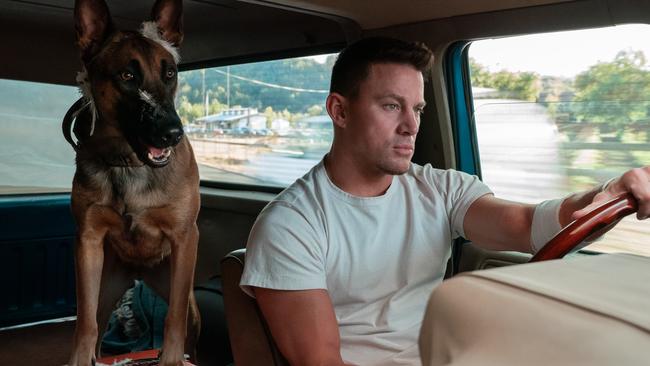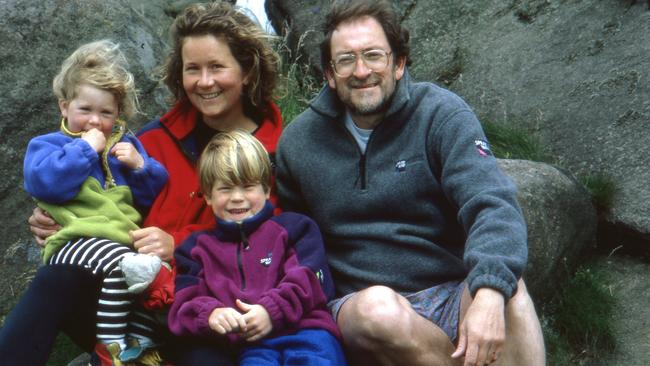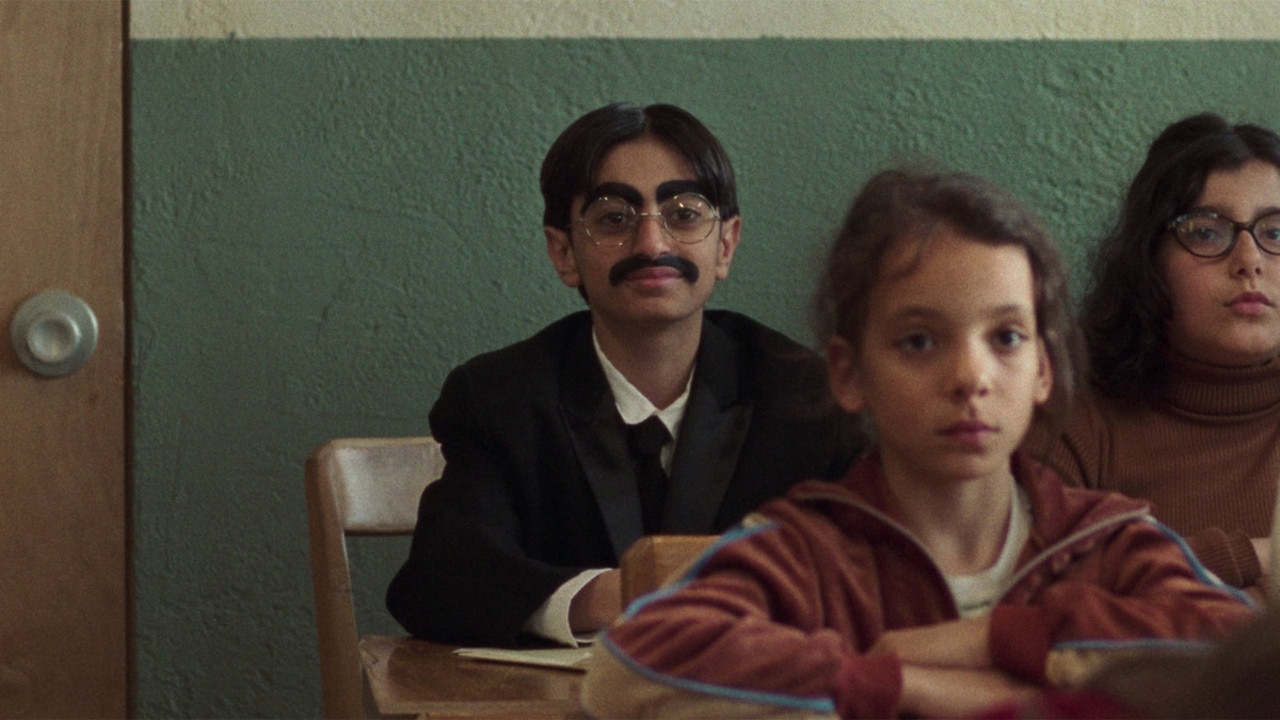Dog Review: Channing Tatum pulls out stops to woo stroppy leading lady
Channing Tatum and his K9 co-star show how an internal war rages long after leaving the battle zone.

Dog (M)
In cinemas
★★★
The American actor Channing Tatum is best known as the male stripper in the Magic Mike movies. He’s a Hollywood hunk: tall, dark (aside from brief flings with blond dye) and handsome.
In his new film, which is his directorial debut, he pulls out all stops to woo his beautiful but stroppy leading lady.
There’s a plush hotel room with an extra soft bed, room service champagne and a shared bubble bath. There are tender moments watching sunsets.
And if he thinks his co-star is being a bit of a bitch he’s safe from being MeToo-ed, as she literally is. He spends most of Dog opposite a belgian malinois, which is one of the go-to breeds for filmmakers at the moment (a pair of them steal scenes from Keanu Reeves and Halle Berry in John Wick 3).
Her screen name is Lulu, named after the star’s late dog. She’s stroppy because she’s an army dog and, after seven deployments into war zones, is suffering from a canine version of post-traumatic stress disorder.
Her handler, an Army Ranger, has died in Afghanistan. His friend and comrade-in-arms, Jackson Briggs (Tatum), has agreed to take her on a long road trip to Arizona so she can attend the funeral.
Briggs, also an Army Ranger, is one of the walking wounded. He suffered brain injuries when an IED exploded, subsequent seizures and is on permanent medical leave.
He, too, worked with Lulu in combat zones. He agrees to be her chaperone in a deal with the higher-ups that he hopes will put him back in uniform.
“This isn’t the same dog you served with,’’ he is warned. “One moment she’s good, next moment she’s sending three guys to ER. You keep her secure and you don’t take her out in public.”
As there’s not much to see if he follows that advice, it’s a fair bet that Lulu will be unmuzzled, unleashed and in public for much of this 101-minute movie.
When she spots a man in Middle Eastern dress in the lobby of that plush hotel in San Francisco, the middle of “woking class America”, her training kicks in. It’s a funny moment that also has a bit of an edge.
This movie is co-directed by Tatum and Reid Carolin, who worked together on the Magic Mike movies.
The script is by Carolin. It is a fictional take on a 2017 HBO documentary they produced: War Dog: A Soldier’s Best Friend.
The debut directors blend comedy and drama, sometimes successfully, sometimes less so. It’s held together by the four leads: Tatum, who has a nice comic touch (“I’ve been shot by the Taliban” is his bar-room pick-up line), and the three dogs who play Lulu, who are beautiful, intelligent and, on screen at least, a little grumpy.
Underneath the humour is the serious message that for a lot of soldiers, including K9 ones, the war inside themselves continues on their return home.
The masterpiece in this subgenre is William Wyler’s 1946 drama The Best Years Of Our Lives. For a more recent example, one that has flown under the radar, I recommend the 2009 movie The Messenger, starring Ben Foster, Woody Harrelson and Samantha Morton.
Dog is not at that level but it’s an entertaining enough movie that adds its voice to the important campaign to raise awareness about post-war trauma.
Lulu is considered a hero. She has saved lives. Yet when Briggs considers the civilians who will be at the funeral, including the dead soldier’s family, he thinks, “If they knew the truth it would scare the living shit out of them”.
Indeed this movie does come with a warning, issued by dog breeders: don’t see it, fall for Lulu and rush out and buy a belgian malinois. They are dogs that need a lot of time, work and commitment. So do dalmatians, and the breeders point to the surge in the number of that breed that ended up in pounds after Disney’s 1997 remake of 101 Dalmatians.
-
The Last Mountain (M)
Available on various streaming services (thelastmountainfilm.com)
★★★★
The visually spectacular, emotionally stirring British documentary The Last Mountain is the sequel no one wanted to make.
In 1995, the 33-year-old British mountaineer Alison Hargreaves decided to climb Mount Everest and K2, alone and without oxygen, almost back-to-back.
She reached both summits – “This is the most fantastic day of my life,’’ she said atop the world’s tallest mountain – but died, three months later, on descent from K2.
Her two children, Tom, then six, and Kate, then four, inherited her love of the mountains, especially her son, who became a professional mountaineer.
Tom Ballard was 30 when he and his Italian climbing companion, Daniele Nardi, died attempting to climb the 8126m-high Nanga Parbat in the Pakistan Himalayas.
Neither his body nor his mother’s have been recovered. It’s believed they rest about 160km apart.
Soon after Hargreaves’s death, her husband, Jim Ballard, took their two children to the K2 base camp so they could farewell their mother.
The family was accompanied by the British filmmaker Chris Terrill and in 1996 he released a BBC documentary, Alison’s Last Mountain.
He remained close to the family and continued to film them.
The extraordinary result of this continued connection is that The Last Mountain, his follow-up documentary about Tom’s life and death, feels like it is made in real time.
We are there, for example, when Kate, on the ground as a search party looks for her brother, telephones her father, at home in Scotland, to tell him two bodies have been found, wearing the same colour parkas as Tom and his co-climber.
The director also uses videos that Tom made throughout his spectacular career, and footage that he and Nardi took in the days leading up to their deaths.
He incorporates interviews with Jim and the children from 1995, a process he continues as they grow older. It is all so poignant: watching the kids speaking in the present tense about their mother when we know what will happen to her. “She is very nice and she is very clever,’’ six-year-old Tom says when asked if his mother will climb K2. “So she’ll do it.”
Here is Tom at 27, by which time he had solo- climbed the six northern faces of the Alps, on the need to keep pushing himself. It’s a question, he says, “of how far to the edge we can go before we topple off”.
Following her brother’s death, Kate decided to go to the base camp of Nanga Parbat, just as she and her brother did for their mother at K2 almost 25 years earlier.
The precise circumstances of Ballard and Nardi’s deaths are not known and probably never will be. Nardi, a decade older, was determined to climb via the Mummery Spur, named after the 19th century English mountaineer Albert Mummery, who died on the route.
There is some suggestion he manipulated Ballard, normally a solo climber, into taking the dangerous ascent, but it is impossible to know and the director does not push this idea too hard. The two Pakistani climbers who joined them at the outset did abandon the climb.
Ballard and Nardi’s bodies were spotted via telescope (and the families permit that image to be shown in this film) but could not be retrieved.
This film is beautiful to look at. It makes me want to go and admire the mountains but not to climb them. To relocate Dorothea Mackellar, they are full of beauty and terror. Ballard’s father and sister grieve Tom’s loss but they believe he died doing what he loved, and would never have stood in his way. They believe his spirit, and his mother’s, are where they should be.
There’s much to reflect on with this group of people who live on a different plane to most of us. The non-mountaineering father, for example, who lies somewhere between Seneca the stoic and Ted Lasso, deserves a film of his own.
One of Nardi’s final social media messages perhaps goes to the essence of this remarkable film. “It’s not just a question of climbing,’’ he wrote before facing the so-called “killer mountain” and heading up the path no-one has completed before or since.
“It is a question of life itself.”





To join the conversation, please log in. Don't have an account? Register
Join the conversation, you are commenting as Logout